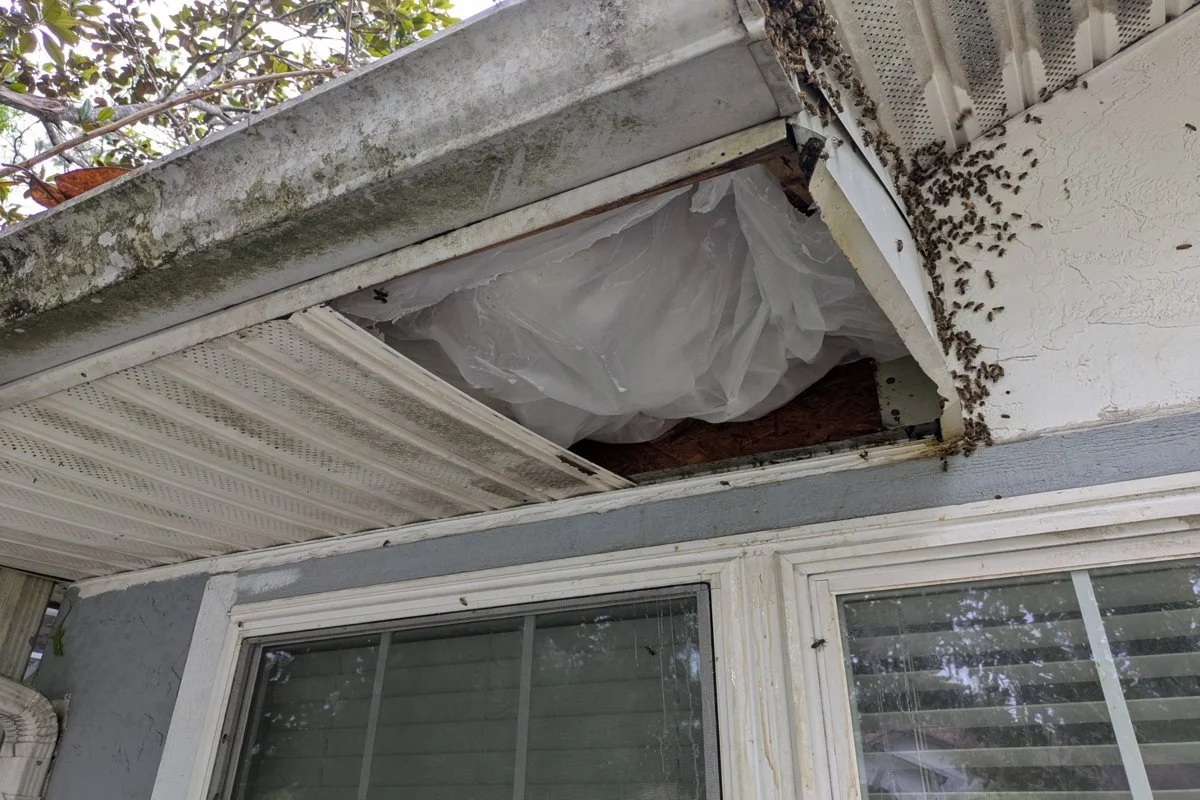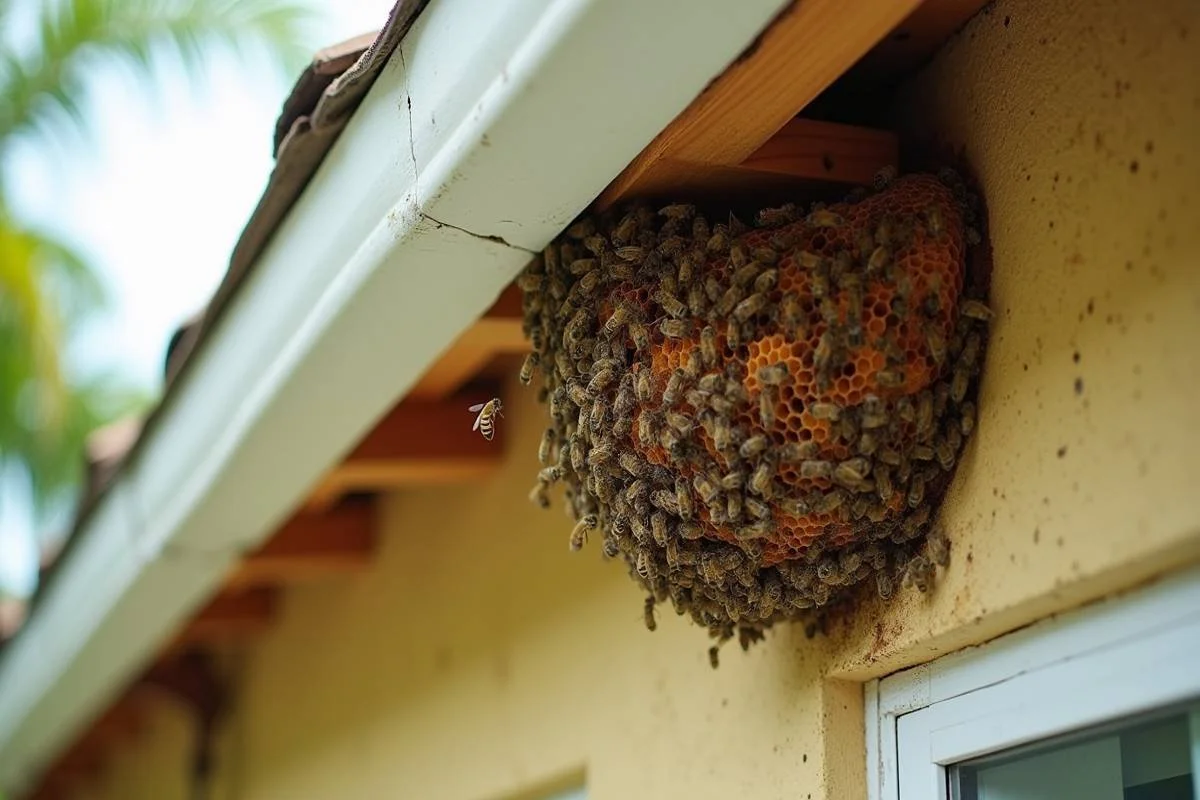Live Bee Removal in Miami: What Every Homeowner Should Know.
Living in Miami, Florida, offers a tropical lifestyle many dream of—sunshine, palm trees, and year-round warm weather. But with this climate also comes a common issue for local homeowners: bee infestations. Across neighborhoods like Coral Gables, Kendall, and Coconut Grove, more and more homeowners are discovering unwanted bee colonies taking up residence inside their homes—often in the attic, soffits, or walls.
At Eco Bee Removal, we provide live bee removal in Miami that’s safe for both homeowners and pollinators. Instead of using harmful chemicals, we relocate bees to safe, controlled environments where they can continue their work without disrupting your home or health. This blog post is your complete local guide to understanding why bee infestations are so common in Miami, how to detect the early signs, and what you should do if bees invade your home.
🐝 Why Miami Homes Attract Bee Colonies
Safely removing a large bee colony from the home exterior.
Miami’s climate makes it a haven for honey bees and other pollinators. The subtropical temperatures allow bees to remain active throughout the year. Unlike northern states where bee colonies go dormant in the winter, bees in Miami continue to forage and expand their hives. This makes the area especially prone to infestations that can occur at any time—even during cooler months.
Additionally, the city’s lush landscaping, flowering gardens, and ornamental fruit trees are a big draw for bees. Bees are naturally attracted to nectar-rich plants, and in neighborhoods like Pinecrest, Doral, and South Miami, floral activity is non-stop. Combined with the architecture of Miami homes—flat roofs, tile-covered eaves, and vent gaps—bees often find easy entry points into your property and begin building large hives hidden behind walls or under soffits.
🔎 Signs of a Bee Infestation in Your Miami Property
If you’re living in the Miami area and suspect a hive may be forming near or inside your home, watch out for some clear indicators. The most common sign is seeing a steady stream of bees entering and exiting from a specific point—usually a roof corner, vent, or crack in the wall. You may also hear a low humming or buzzing sound inside your walls or attic, especially at night when the house is quiet.
Another major sign is the appearance of brown stains on your walls or ceiling. These stains are often caused by honey dripping through drywall from a hive hidden behind it. If you notice any of these symptoms in your home, it’s crucial to act quickly. Bee colonies in Miami can grow fast and become a much larger problem in just a few weeks.
⚠️ The Risks of DIY Bee Removal in Miami
Many Miami homeowners attempt to handle bee problems themselves, often by spraying insecticides or sealing entry points. However, DIY bee removal can be dangerous and counterproductive. For one, certain bee species found in Miami—like Africanized honey bees—are highly defensive and may attack when threatened.
Moreover, sealing up a hive entrance doesn’t remove the bees—it traps them inside. Trapped bees can die and decompose, creating foul odors and attracting other pests like ants, flies, and rodents. You might also violate Florida’s environmental regulations, as bees are considered protected pollinators. The Florida Department of Agriculture encourages humane bee removal over extermination. That’s why hiring a licensed, local professional who specializes in live bee removal in Miami is always the safer, smarter choice.
🛠️ How Professional Bee Removal Works in Miami
When you call Eco Bee Removal, you get expert service backed by years of local experience. Our process starts with a free inspection anywhere in Miami-Dade County. We check the hive’s location, assess the species of bee, and determine the size and complexity of the infestation.
Once we’ve confirmed the situation, we begin the live removal process. Using specialized tools and non-toxic bee vacuums, we gently extract the bees from your home without harming them. Protective suits, slow techniques, and precision equipment ensure that both you and the colony remain safe throughout the process.
After the bees are removed, we open up the area—such as a soffit or wall cavity—to remove the hive, honeycomb, wax, and all remaining residue. This is crucial because leaving any part of the hive behind could attract future swarms or pests. Once everything is cleared, the bees are relocated to a managed apiary in the Miami area where they can live safely and continue pollinating. Finally, we seal off all entry points and offer minor repair services to ensure bees don’t return.
🌿 Why Choose Live Bee Removal Instead of Spraying
Choosing live removal instead of extermination isn’t just better for the environment—it’s also better for your home. Spraying only kills the visible bees, leaving the hive and queen intact. This means the infestation can return within days or weeks.
Live bee removal ensures the complete removal of the hive and the successful relocation of the entire colony. Plus, it aligns with Florida’s environmental guidelines and helps support the local ecosystem. Pollinators are essential for Florida agriculture and biodiversity, and saving them is a responsibility we all share.
🐝 What Types of Bees Are Found in Miami?
Bee hive under house roof with active bees
Miami is home to several bee species, each requiring a slightly different removal approach. The European honey bee is the most common and is known for being docile and ideal for relocation. Africanized bees, sometimes called “killer bees,” are more aggressive and are also found throughout South Florida. Carpenter bees are often seen burrowing into wooden decks or fascia boards, and sweat bees, though harmless, are attracted to human skin and are common during humid seasons.
🧠 Bee Prevention Tips for Miami Homeowners
The best way to avoid a costly infestation is through prevention. Homeowners in Miami should routinely inspect their soffits, rooflines, attic vents, and wall gaps for cracks or holes. Installing metal mesh over vents and sealing any gaps with caulk or foam can keep bees from entering. Avoid planting too many flowering plants right up against the house, and keep sugary drinks or fruit indoors, especially during summer.
If you’re unsure whether your home is bee-proof, Eco Bee Removal offers inspections and preventive consultations throughout Miami and the surrounding communities.
📍 Real Bee Case in Coral Gables
A recent client in Coral Gables contacted us after noticing bees gathering near an exterior bedroom wall. After inspection, we found a 4-foot-long honeycomb hidden behind insulation. Using our live removal process, we safely extracted over 30,000 bees, removed the entire hive, and sealed the entry point. The bees were relocated to a nearby apiary in Homestead, and the homeowner was thrilled that the problem was solved humanely.
🙋 Frequently Asked Questions
How much does bee removal cost in Miami?
It varies based on access and hive size. Most jobs range from $200 to $600. We offer free estimates and transparent pricing.
Can you remove bees from condos or high-rises in Downtown Miami?
Yes. We’re equipped to handle removals in high-rise buildings in Brickell, Edgewater, and other urban areas.
Is live bee removal legal in Florida?
Yes, and it’s encouraged. Eco Bee Removal complies with all local and state guidelines for ethical bee relocation.
📞 Call the Bee Removal Experts in Miami Today
If you notice bees flying in and out of your walls, roof, or attic, don’t wait. Miami’s warm climate helps colonies grow quickly, turning small infestations into major issues. At Eco Bee Removal, we serve all of Miami-Dade County, including Hialeah, Kendall, Homestead, Coral Gables, and Miami Beach.
Call us today at (888) 282-1886 to schedule a free consultation. Protect your home, protect your family, and save the bees—safely and responsibly.


